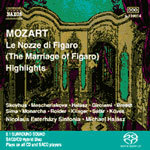
Mozart, W.A. - Le Nozze di Figaro (The Marriage of Figaro) K. 492 (Highlights)
 $28.00
Out of Stock
$28.00
Out of Stock6+ weeks add to cart
Mozart, W.A. - Le Nozze di Figaro (The Marriage of Figaro) K. 492 (Highlights)
Michelle Breedt, soprano / Renato Girolami, bass / Judith Halasz, soprano / Alexander Klinger, tenor / Peter Koves, bass / Marina Mescheriakova, sopra
[ Naxos SACD / SACD ]
Release Date: Wednesday 7 July 2004
This item is currently out of stock. It may take 6 or more weeks to obtain from when you place your order as this is a specialist product.
On Hybrid Super Audio CD (SACD) format, presented in full 5.1 surround sound! PLAYABLE ON ANY CD SYSTEM - "The MArriage of Figaro" won considerable success both in Vienna and subsequently in Prague, and was revived in the former in 1789, when two new arias were substituted for Susanna, the second of which, from the last act, is here included.
On Hybrid Super Audio CD (SACD) format, presented in full 5.1 surround sound! PLAYABLE ON ANY CD SYSTEM
In Mozart's native Salzburg, where he had been intermittently employed at the court of his father's patron, the Archbishop, there had been little opportunity for the composition of opera, a form towards which his ambitions had always tended. As a boy he had responded to opportunities offered in Milan and in 1781 saw his opera Idomeneo staged in Munich. In the same year, during a visit to Vienna in the entourage of the Archbishop, he broke with his employer, establishing himself in the imperial capital in initially successful but precarious independence. An early opportunity came in a German opera, Die Entführung aus dem Serail, for the new German company encouraged by the Emperor. It was only in 1786 that further chance offered itself with a commission for an Italian opera for the court theatre. This was a setting of a libretto by Lorenzo Da Ponte based on the second of the plays by Beaumarchais on the subject of Figaro, barber of Seville and now steward to Count Almaviva, whose marriage he had successfully aided.
The opera won considerable success both in Vienna and subsequently in Prague, and was revived in the former in 1789, when two new arias were substituted for Susanna, the second of which, from the last act, is here included. The choice of subject had seemed, in the climate of the time, open to criticism and the play by Beaumarchais had, in fact, been banned as possibly subversive in its overt ridicule of the aristocracy. Da Ponte's libretto, however, met with the Emperor's approval, an idiomatic translation of the original French play into Italian operatic form
Tracks:
01. Sinfonia 04:12
02. Act I No. 3: Cavatina - Se vuol ballare, signor Contino 02:44
03. Act I No. 4: Aria - La vendetta, oh, la vendetta 03:37
04. Act I No. 6: Aria - Non so piu cosa son, cosa faccio 02:32
05. Act I No. 10: Aria - Non piu andrai, farfallone amoroso 04:03
06. Act II No. 11: Cavatino - Porgi amor qualche ristoro 03:50
07. Act II No. 12: Arietta - Voi, che sapete 02:51
08. Act II No. 13: Aria - Venite, inginocchiatevi 03:16
09. Act II No. 15: Duettino - Aprite, presto, aprite 01:13
10. Act II No. 16: Finale - Voi, signor, che giusto siete 03:54
11. Act III No. 18: Recitativo - Hoi gia vinta la causa! / Aria - Vedro, mentr'io sospiro 04:55
12. Act III No. 20: Recitativo - E Susanna non vien!... / Aria - Dove sono i bei momenti? 06:00
13. Act IV No. 28: Recitativo - Giunse al fin il momento / Rondo - Al desio di chi t'adora 07:34
14. Act IV No. 29: Finale - Pian pianin le andro piu presso 01:30
15. Act IV No. 29: Finale - Ecco qui la mia Susanna! 04:58
16. Act IV No. 29: Finale - Tutto e tranquillo e placido 03:53
17. Act IV No. 29: Finale - Pace, pace, mio dolce tesoro 02:00
18. Act IV No. 29: Finale - Gente, gente, all'armi, all'armi! 05:21